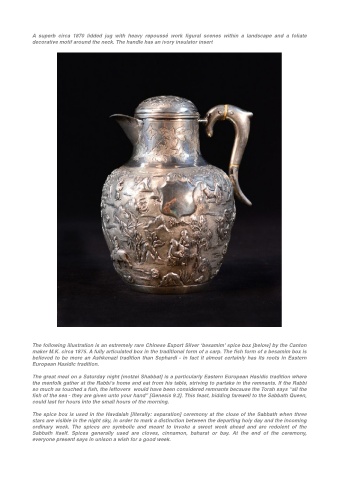Page 534 - Chinese SIlver By Adrien Von Ferscht
P. 534
A superb circa 1870 lidded jug with heavy repoussé work figural scenes within a landscape and a foliate
decorative motif around the neck. The handle has an ivory insulator insert
The following illustration is an extremely rare Chinese Export Silver ‘besamim' spice box [below] by the Canton
maker M.K. circa 1875. A fully articulated box in the traditional form of a carp. The fish form of a besamim box is
believed to be more an Ashkenazi tradition than Sephardi - in fact it almost certainly has its roots in Eastern
European Hasidic tradition.
The great meal on a Saturday night [motzei Shabbat] is a particularly Eastern European Hasidic tradition where
the menfolk gather at the Rabbi’s home and eat from his table, striving to partake in the remnants. If the Rabbi
so much as touched a fish, the leftovers would have been considered remnants because the Torah says “all the
fish of the sea - they are given unto your hand” [Genesis 9.2]. This feast, bidding farewell to the Sabbath Queen,
could last for hours into the small hours of the morning.
The spice box is used in the Havdalah [literally: separation] ceremony at the close of the Sabbath when three
stars are visible in the night sky, in order to mark a distinction between the departing holy day and the incoming
ordinary week. The spices are symbolic and meant to invoke a sweet week ahead and are redolent of the
Sabbath itself. Spices generally used are cloves, cinnamon, baharat or bay. At the end of the ceremony,
everyone present says in unison a wish for a good week.

